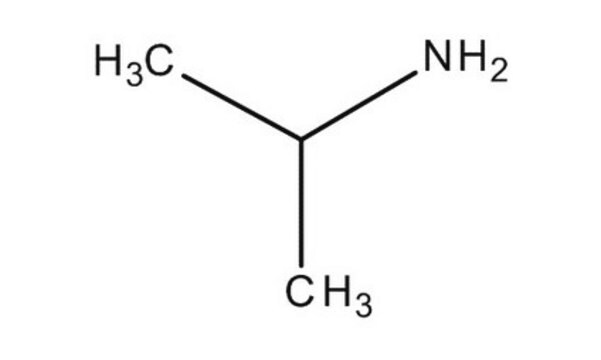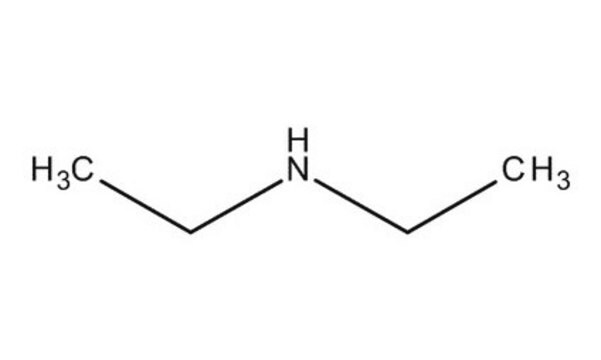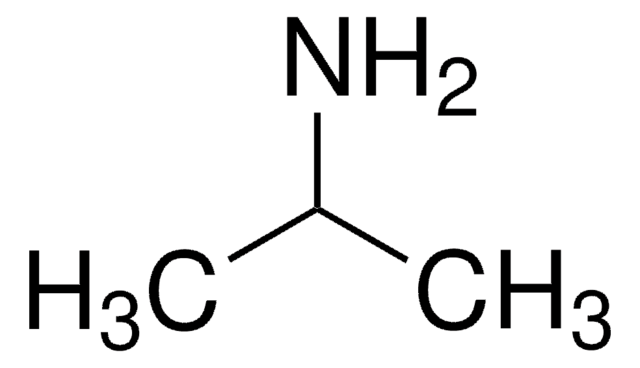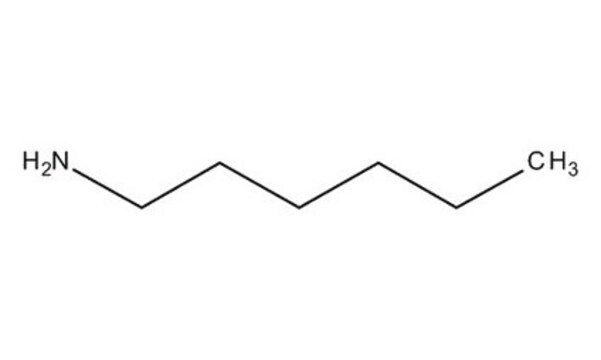8.07477
Propylamine
for synthesis
Synonym(e):
Propylamine, 1-Aminopropane
About This Item
Empfohlene Produkte
Dampfdruck
330 hPa ( 20 °C)
Qualitätsniveau
Assay
≥99.0% (GC)
Form
liquid
Selbstzündungstemp.
325 °C
Wirksamkeit
370 mg/kg LD50, oral (Rat)
400 mg/kg LD50, skin (Rabbit)
Expl.-Gr.
2.1-13.6 % (v/v)
pH-Wert
12.6 (20 °C, 100 g/L in H2O)
mp (Schmelzpunkt)
-83 °C
Übergangstemp.
flash point <-35 °C
Dichte
0.72 g/cm3 at 20 °C
Lagertemp.
2-30°C
InChI
1S/C3H9N/c1-2-3-4/h2-4H2,1H3
InChIKey
WGYKZJWCGVVSQN-UHFFFAOYSA-N
Anwendung
- Computational study of the unimolecular and bimolecular decomposition mechanisms of propylamine: A computational analysis revealed detailed reaction mechanisms for propylamine, focusing on dehydrogenation processes which could be crucial for developing better industrial synthesis techniques (Almatarneh et al., 2020).
- Structural transformation and tuning behavior induced by propylamine concentration in hydrogen clathrate hydrates: This study provides fundamental understanding of guest-host distributions in clathrate hydrates, which are vital for applications in gas storage and separation technologies (Park et al., 2015).
- Molecular association of small amphiphiles: Origin of ionic liquid properties in dibutyl phosphate/propylamine binary mixtures: The study explores the dynamic properties of propylamine mixtures, which could inform the development of new materials with ionic liquid-like characteristics for various industrial applications (Liveri et al., 2018).
Hinweis zur Analyse
Dichte (d 20 °C/ 4 °C): 0.716 - 0.717
Wasser (K. F.): ≤ 0.20 %
Identität (IR): entspricht
Signalwort
Danger
Gefahreneinstufungen
Acute Tox. 3 Dermal - Acute Tox. 3 Inhalation - Acute Tox. 4 Oral - Eye Dam. 1 - Flam. Liq. 2 - Met. Corr. 1 - Skin Corr. 1B - STOT SE 3
Zielorgane
Respiratory system
Lagerklassenschlüssel
3 - Flammable liquids
WGK
WGK 1
Flammpunkt (°F)
-31.0 °F
Flammpunkt (°C)
< -35 °C
Analysenzertifikate (COA)
Suchen Sie nach Analysenzertifikate (COA), indem Sie die Lot-/Chargennummer des Produkts eingeben. Lot- und Chargennummern sind auf dem Produktetikett hinter den Wörtern ‘Lot’ oder ‘Batch’ (Lot oder Charge) zu finden.
Besitzen Sie dieses Produkt bereits?
In der Dokumentenbibliothek finden Sie die Dokumentation zu den Produkten, die Sie kürzlich erworben haben.
Kunden haben sich ebenfalls angesehen
Unser Team von Wissenschaftlern verfügt über Erfahrung in allen Forschungsbereichen einschließlich Life Science, Materialwissenschaften, chemischer Synthese, Chromatographie, Analytik und vielen mehr..
Setzen Sie sich mit dem technischen Dienst in Verbindung.












